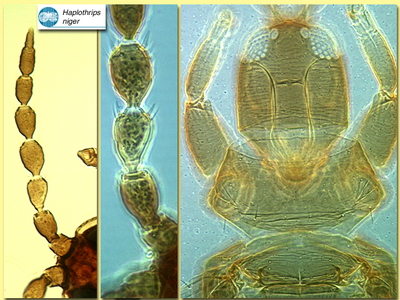Species
Haplothrips niger Osborn
Figures
Fig. 1 Antenna, head and pronotum
Fig. 2 Head, fore tibia and tarsus, tergite IX and X (tube)
Fig. 3 Tergites IV-VI with wing retaining setae
Biology
Commonly found in red clover flowers (Trifolium), of which it is sometimes considered a pest. However, this is possibly only a parthenogenetic strain of H. leucanthemi Schrank, a bisexual flower-living species on Chrysanthemum leucanthemum.
Distribution
Described from North America, and recorded from Europe, South America, Australia and New Zealand.
Recognition
Large dark thrips, antennal segment III paler at base; forewing pale with extreme base dark. Antennae 8-segmented; segment III with 2 sense cones, IV with 4 sense cones; segment III about equal in length to IV. Head with maxillary stylets about one-third of head width apart, with distinct maxillary bridge; postocular setae short with apex acute and not extending to posterior margin of eye. Pronotum with all 5 pairs of major setae short and acute, anteromarginals not distinguished from discals. Fore tarsus of female with minute tarsal tooth. Forewing constricted medially; distal posterior margin with about 5 duplicated cilia; sub-basal setae acute and shorter than basal width of wing. Tergites II-VII each with 2 pairs of sigmoid wing-retaining setae; tergite IX mid-dorsal setae blunt and scarcely half as long as the tube, lateral setae acute.
Related species
The very short setae on the pronotum and head distinguish this species from most members of the large genus Haplothrips.




